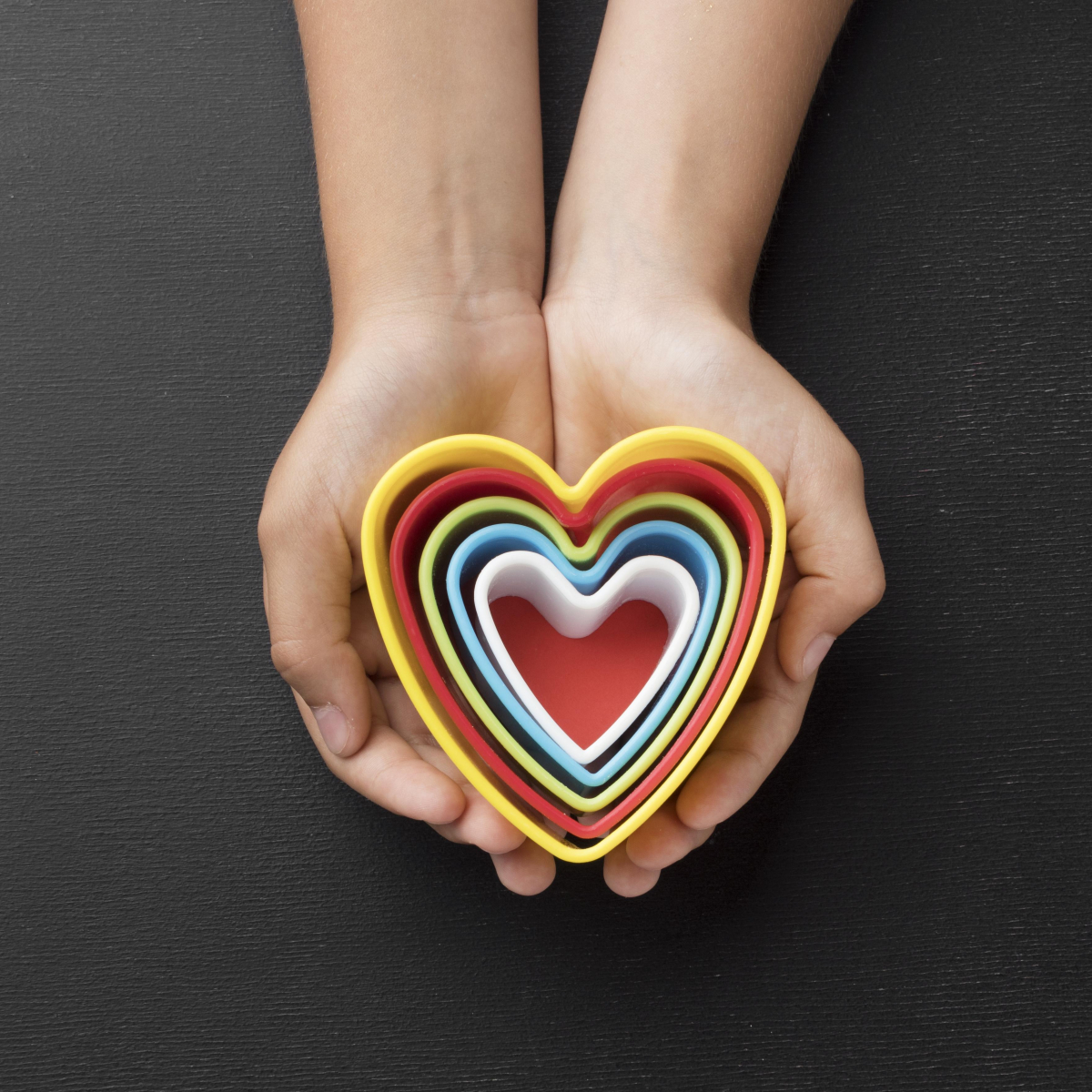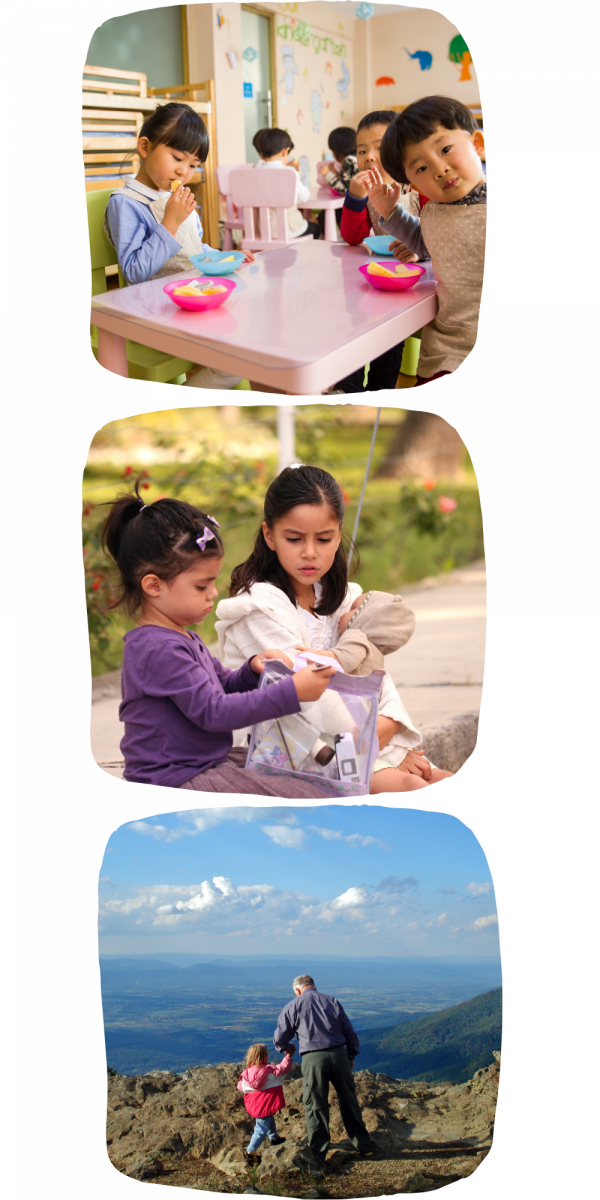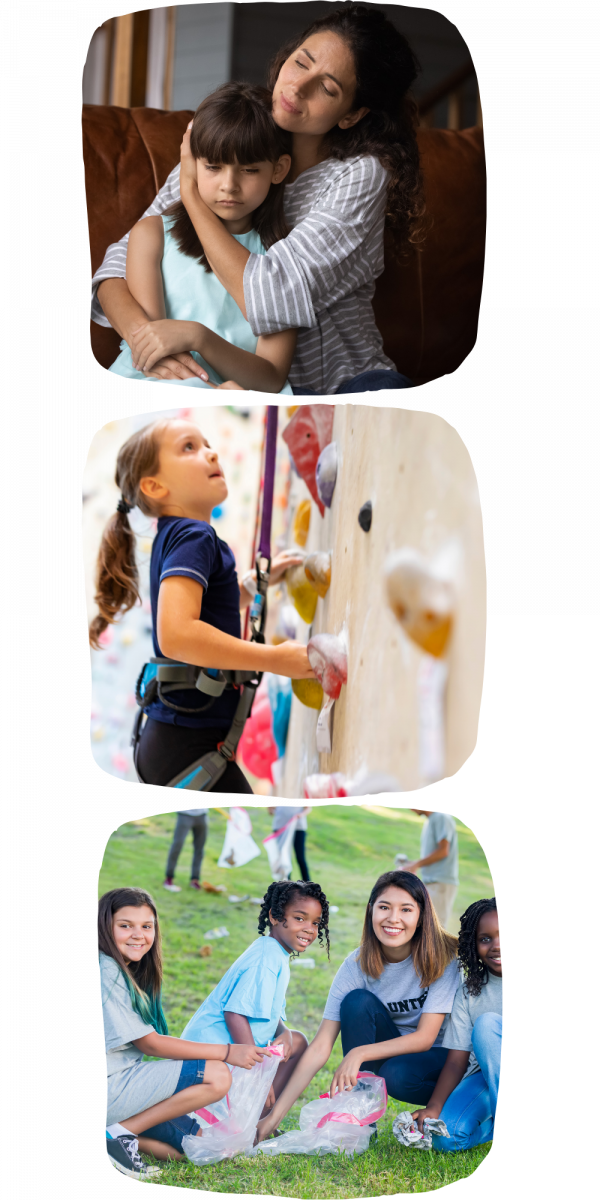
Conflict, whether at home or abroad, can be deeply unsettling for children of all ages. Regardless of the physical distance between young people and a conflict zone, hearing about violence or war elsewhere often sparks fears of “what if” that can undermine their sense of Security & Calm. If war can erupt elsewhere, what’s to stop it from happening here? Children are intrinsically Compassionate & Kind, and hearing about others’ intense suffering, whether locally or on the other side of the globe, can be upsetting or even traumatizing.
Times of conflict call upon adult caregivers to hold young people’s hearts more tenderly and fiercely – to provide reassurance that young people are safe and loved, to provide perspective on distressing events that is grounded in facts, and to help young people channel empathic distress into compassionate action. The following tips provide practical, age-appropriate suggestions for supporting children through global unrest.
3 Tips for Supporting Children in Times of Conflict
- Understand what holding hearts is all about: Holding young people’s hearts through times of conflict requires more than talking with them about what they’ve seen on the news. It means viewing them as full humans with complex emotional lives that they often struggle to make sense of. [1]
- Resource yourself: As a caregiver, you are your child's number one resource[2] for feeling Secure & Calm. Even on days when you are far from your best, what you have to offer them is good enough. In stressful times, your loving presence is what will help them feel Secure & Calm enough to venture out into the world with their big, vulnerable, Compassionate & Kind hearts open wide.
- Nurture compassion, not suffering: Research shows that empathy can drive two responses – empathic distress, which involves identifying with the person who is suffering and sharing in their pain and emotions, and empathic concern[3], which focuses on others and can lead to positive feelings and motivation to help. Help young people cultivate Compassionate & Kind in response to others’ distress by regularly talking about and naming their feelings, such as through the Mood Meter, and by practicing mindfulness together through play.
Holding Hearts in Times of Conflict: An Age-Based Guide
Click the "Download" button above to view a colourful, age-by-age infographic describing these heart-holding practices.
Infants and toddlers
- More affected by caregivers' stress and emotions than world events
- Not developmentally able to understand abstract concepts like war
- May mimic overheard words
- Show their thoughts and feelings through play and art[4]
- If needed, talk about conflict in very simple and reassuring terms[5]
Practical ways to hold very young children’s hearts in these times include:
- checking in with yourself[6]
- holding, humming, and swaying[7]
- recognizing their feelings[8]
- focusing on play[9]
Preschool-aged children 
- Beginning to understand concepts such as death and war, but lack the developmental ability to grasp their complexities
- Struggle to understand the difference between fictional violence, such as in a movie, and real violence portrayed on the news
- May fixate on emotionally charged concepts like death in play or speech
- Assess what they know through art, play, drama, or talking calmly together
- "Add in" clarifying, confirming, and reassuring facts[10] as needed
- Signs of anxiety or traumatic stress[11] include an increase in hard-to-manage behaviors, temper tantrums, problems listening at home or at school, change in sleep patternsm increased sensitivity or irritability, and hypervigilance
Practical ways to hold young children’s hearts in these times include:
- leaning on routines, rules, and boundaries[12]
- playing with dolls[13]
- planning for the future[14]
- talking while moving[15]
School-aged children
- Younger school-aged children are able to understand at least part of what war means, and older school-aged children are often able to imagine the possible outcomes of violent conflict
- Can distinguish between fictional and actual violence
- Have many influences that can serve as possible exposures to information about conflict
- If you think they might be concerned or notice signs of distress, ask them what they've heard and listen attentively [16]without judgement
- It can be beneficial to limit their exposure to violent and disturbing media and to be with them during exposures
- Reassure them often that you will keep them safe and help them cope
Practical ways to hold school-aged children's hearts in these times include:
- depersonalizing and focusing on differences[17]
- being their brave[18]
- making time for things they enjoy[19]
- being the helpers[20]
Photo credit[21]
The first step to soothing children in this age range is to manage our own fears and anxieties. Our emotions can sometimes spill over when the world feels overwhelming, and that is okay so long as we are keeping ourselves and the young people we care for safe. Signs that indicate adult stress may be affecting infants and toddlers include: being fussier or harder to soothe, experiencing changes in their sleeping or eating patterns, or seeming withdrawn.
Holding your child is inherently soothing for both child and adult. Humming soothes the nervous system, and gentle, rhythmic movement like swaying is deeply regulating. Plant your feet and root into your toes as you hold your child against your chest, hum a song they love, and gently sway. Try making this a regular routine, such as before bedtime, to structure soothing into your day.
Infants and toddlers are unique beings who experience a full spectrum of emotion and are highly attuned to the emotional state of their caregivers. Babies can sense if their emotional needs are recognized and responded to, which is harder to do when the caregiver is distracted by their own worries or fears. Seek out extra support if needed so that you can care for your own emotional well-being as an investment in your ability to attune to and support your child throughout their emotional ups and downs.
Get down on your child’s level and give them your full attention for just 20 minutes – set a timer if you need to. For infants, this might look like tummy time, playing peekaboo, or mirroring their sounds and movements to foster attunement. Let toddlers take the lead with an activity of their choice, such as pretend play, dress-up, exploring nature, or art.
Doing so requires understanding that, depending on their stage of development and temperament, they have varying levels of ability to take in, understand, and cope with upsetting news about their world and the emotional states of the adults around them. It also requires shining a mirror towards yourself as a caregiver to assess your own capacity to cope with upsetting news and regulate difficult emotions.
Recognize that as their most valuable resource, you can’t neglect to resource yourself: practice emotion regulation self-care such as Somatic Experiencing to build resilience in your nervous system, and practice gratitude in the face of fear to resource yourself with joy.
They key to fostering empathic concern, which reflects the Compassionate & Kind Heart-Mind Quality, lies in differentiating from the person who is suffering while holding your heart open to care about their pain.
Children are likely to respond in this way if they have been exposed to upsetting information, images, or events that they struggle to make sense of while maintaining a sense of Secure & Calm. Preschool-aged children aren't able to verbally articulate overwhelming, complex feelings, so communicate how they feel through their behaviors. Oppositional or non-compliant behaviors are common when young children are coping with a stressor. More frequent "acting out" is also common as a way for them to assert control over their environment and caregivers as they attempt to manage their anxieties. Hypervigilance, or being on the look out for threats in their environment, is another common response - which may include placing their hands on their ears to guard against sudden loud noises.
Routines, rules, and boundaries provide emotional safety and containment that are vital for children to feel Secure & Calm. Predictability and stability are key for rebuilding feelings of trust and safety after a distressing exposure or event. Children need to know that their caregivers are in charge, in control, and will keep them safe. Having consistent rules and boundaries helps communicate that. Routines provide predictability, which also enhances feelings of safety.
Doll play encourages children to talk about other's thoughts and emotions. Doing so can help them develop empathy in a way that differentiates self from others and motivates helping - which cultivates Compassionate & Kind. Join them in their doll play and let them take the lead - listen to what types of thoughts and feelings they are assigning their dolls, and mirror their ideas and language as you meet them in their play scenes.
When children are unsettled, the future can feel uncertain and frightening. Normalize living with uncertainty by planning things (that are within your control) that they enjoy. Weave reassuring future statements into your conversations at transition times like drop-offs and pick-ups, such as "When I pick you up from soccer, we'll have pizza for dinner and watch a movie - your choice!" Make longer term plans that they can look forward to and talk about them often to paint the future as something positive and exciting: "Once school is over for the year we will spend a week camping by the beach and Grandma and Grandpa will join us. What games should we pack for around the campfire?"
Emotions move us, and we can also move through them. Go for a walk, kick a ball in the backyard, or plan a weekend hike to talk through things that are on your child's mind. Moving while talking about distressing thoughts or feelings can help children and adults alike move through them without getting stuck in a fear, stress, or trauma response.
Children of this age, especially pre-teens, can often feel like everything is about them. They may be likely to perceive threats to themselves and their family that don't exist as a result. As Karen Young suggests, focusing on the differences between their situation and the crisis situation can help them depersonalize and enhance their peace of mind. Try to identify differences together; in the context of global conflict, differences might include geographical location, government resources, and historical relations. Anxiety will draw their minds to the similarities that make them feel at-risk, but highlighting differences can help them zoom-out and step back from their fears.
Being children's brave has two parts: first, acknowledging that their worries and fears are real and upsetting (rather than minimizing them in an attempt to protect them from their own feelings), and second, giving them strong signs of safety. Let them know that you see their fears and you're on their side; that despite how big or scary things feel right now, you've got them and you know that everything will be alright.
While children may feel naturally inclined to withdraw when they are stressed or scared, pulling away from the people and activities they love won't help them in the long run. Support children to stick with activities and social time that usually brings them joy - even if it's harder for them to feel it at this time. Prioritize rest, too, as feeling anxious can use up a lot of physical and emotional energy. If your child is feeling up to a challenge, encourage them to try an activity that they've never done before, like rock climbing, kayaking, or yoga. The triumph of doing something new can help combat feelings of anxiety about things going on in the world that are outside of their control.
While the saying "look for the helpers" is well-known, why stop there when you can be the helpers? Action in the face of fear is an excellent way to dial down anxiety, feel empowered, and nurture Compassionate & Kind. Find out what initiatives are running locally to support those affected by conflict or contribute to online fundraisers run through reputable humanitarian organizations and spread the word about them your online networks.
The best way to get a sense of what they are feeling or thinking is through play – notice if there are recurring themes in their play that seem “stuck,” as this can be an indicator of distress. Art is another way to get a sense of what is on their mind – children as young as two may be able to tell you a story about their art, which you can offer to write down for them.
While children this age do not need to know about international conflict, if you feel compelled to talk with them about it, be sure to keep it simple and age-appropriate, such as “Some people in different countries are upset with each other and are fighting about it. [caregiver’s name] keeps you safe and loves you very much.”
For example, you can confirm and reassure with a phrase like: "Yes, there are two countries that are angry at each other who are fighting. Did you know that they are super far away from us?"
"Add in" positive emotions to balance out heavy feelings: psychologist Karen Young suggests adding confidence in the face of uncertainty, and gratitude in the face of sadness.
Correct misperceptions in a warm, loving, and matter-of-fact way, treating them and their opinions with the same respect you would afford to an adult. If they ask questions, keep your explanations simple and age-appropriate, using similar language and tone to what you might use to discuss other challenging questions about life and death.
Lead image from freepik.com


